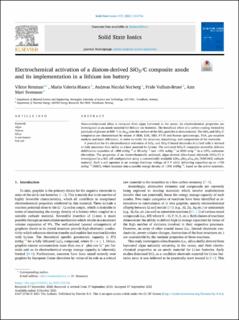| dc.contributor.author | Renman, Viktor | |
| dc.contributor.author | Blanco, Maria Valeria | |
| dc.contributor.author | Norberg, Andreas Nicolai | |
| dc.contributor.author | Vullum-Bruer, Fride | |
| dc.contributor.author | Svensson, Ann Mari | |
| dc.date.accessioned | 2021-10-20T12:01:32Z | |
| dc.date.available | 2021-10-20T12:01:32Z | |
| dc.date.created | 2021-10-15T17:51:01Z | |
| dc.date.issued | 2021 | |
| dc.identifier.citation | Solid State Ionics. 2021, 371 1-12. | en_US |
| dc.identifier.issn | 0167-2738 | |
| dc.identifier.uri | https://hdl.handle.net/11250/2824133 | |
| dc.description.abstract | Nano-architectured silica is extracted from algae harvested in the ocean. Its electrochemical properties are investigated as an anode material for lithium ion batteries. The beneficial effect of a carbon coating formed by pyrolysis of glucose at 850 °C in Ar(g) onto the surface of the SiO2 particles is demonstrated. The SiO2 and SiO2/C composites are characterized by means of SEM, EDX, XRD, FT-IR and Raman spectroscopy, TGA, gas sorption analysis and laser diffraction, in order to verify the structure, morphology and composition of the materials. A procedure for the electrochemical activation of SiO2- and SiO2/C-based electrodes in Li half cells is devised to fully maximize their utility as a host material for Li-ions. The activated SiO2/C composite reversibly delivers delithiation capacities of ≈800 mAhg−1 at 50 mAg−1 and ≈450 mAhg−1 at 2000 mAg−1 in a LiPF6‑carbonate electrolyte. The properties of an electrochemically activated, algae-derived silica-based electrode (SiO2/C) is investigated in a full cell configuration using a commercially available LiNi0.4Mn0.4Co0.2O2 (NMC442) cathode material. Such a cell operates at an average discharge voltage of 3 V while delivering capacities up to ≈150 mAhg−1 (NMC), which translate into a specific energy density of ≈390 mWhg−1, based on the active materials. | en_US |
| dc.language.iso | eng | en_US |
| dc.publisher | Elsevier | en_US |
| dc.rights | Navngivelse 4.0 Internasjonal | * |
| dc.rights.uri | http://creativecommons.org/licenses/by/4.0/deed.no | * |
| dc.title | Electrochemical activation of a diatom-derived SiO<inf>2</inf>/C composite anode and its implementation in a lithium ion battery | en_US |
| dc.type | Peer reviewed | en_US |
| dc.type | Journal article | en_US |
| dc.description.version | publishedVersion | en_US |
| dc.source.pagenumber | 1-12 | en_US |
| dc.source.volume | 371 | en_US |
| dc.source.journal | Solid State Ionics | en_US |
| dc.identifier.doi | 10.1016/j.ssi.2021.115766 | |
| dc.identifier.cristin | 1946333 | |
| dc.relation.project | Norges forskningsråd: 274969 | en_US |
| cristin.ispublished | true | |
| cristin.fulltext | original | |
| cristin.qualitycode | 1 | |

